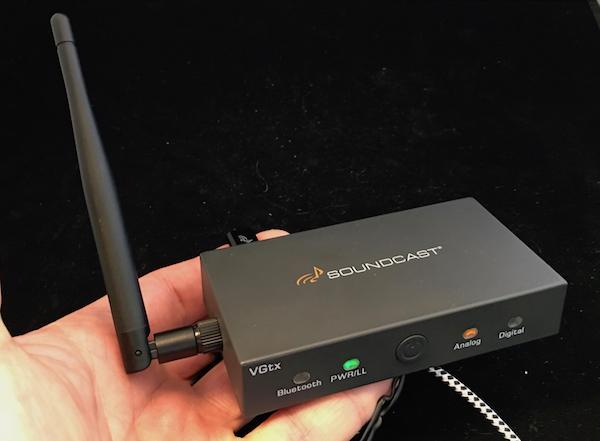Soundcast's VGtx Is a Super-Fast Bluetooth Super Blaster

I've never had much love for Bluetooth, especially when used for wireless audio. Over the years, my experience with the now 24-year-old wireless technology—developed in 1994 by Ericsson for use as a wireless replacement for RS-232 data cables—has been plagued by the devices' capricious willingness of devices to pair (or not to pair, is that the question?) Bluetooth audio quality has only recently managed to rise above the level of low-quality mp3 mediocrity. The latency in the Bluetooth audio signal often caused lip-sync issues so discombobulating that it was nearly impossible to use Bluetooth speakers or headphones when watching movies.
The pro-audio aptX audio codec was adapted for Bluetooth, and the first Bluetooth-equipped consumer headset with aptX was introduced by Sennheiser in 2009 (a full two decades after the original aptX codec was developed). The aptX audio codec provided "CD-like quality audio" with relatively low latency in the audio signal. In 2016, the aptX HD "high-resolution" version of the codec was released, supporting 48kHz/24bit LPCM audio data and proclaimed to be "indistinguishable from high resolution audio". Distracting latency issues still remained for gamers and movie watchers, however; and this led to the development of aptX Low Latency. Whereas delays in stereo audio over Bluetooth typically ranged between 100-150 ms, the timing offset using the aptX Low Latency was more like 40 ms. (If you want to see a good demo of how annoying longer delay times are when watching video, take a look at the demo video below.)
By the way, aptX, in all its flavors, is backwards compatible with standard Bluetooth audio codecs. In order to take advantage of the full benefits of the faster encoding/decoding transmission speed, though, both the transmitting and receiving devices have to include the aptX Low Latency version of the codec. In this particular case, the Soundcast VGtx transmitter and the VG5 Bluetooth speaker have built-in Bluetooth with aptX Low Latency.
It's amazing how much of a difference it makes, too. A delay time of differential of 60-to-90 ms doesn't sound like that big of a deal—after all, a millisecond is a damn short period of time. But it does matter. It matters a lot. Our brains are really good at noticing that short of a delay between when our eyes see something and when our ears hear the associated sound. The VGtx scores big points on that aspect.
Although the specified range of the majority of consumer Bluetooth devices is approximately 10 meters (33 feet), the distance the Bluetooth signal will actually travel is highly dependent upon the antenna configuration, battery strength, and physical materials that may lie between the transmitting and receiving devices. My house, for example, has a 12-inch thick wall running the center of the building. It's one of the reasons why I say my home is "the place where wireless signals come to die." Outside where there's nothing to block the signal, however, the signal will have a much longer reach.
The Soundcast VGtx has a high-power, long-range Bluetooth transmitter built-in, giving it an estimated transmission range of up to 150 feet (about 45 meters). As you might guess, that extra power makes a big difference. Whereas a lower-power Bluetooth device, such as my iPhone, could barely get a stable signal from one side of that 12-inch wall to the other; I could receive the signal blasted by the VGtx over 25 feet away on the opposite side of the wall.
When I placed the VGtx on the interior side of one of the windows in my house, I was able to walk around 35 feet from the window before the signal began to degrade and break up. That's around 2-3 times what I'd get with my iPhone as the transmitting device. When I placed the VGtx outside the house on the other side of the window, I made it 160 feet away before losing a consistent signal. That's mighty impressive.
The VGtx includes a 3.5-millimeter audio input jack along with an optical digital audio input with pass-through. The optical pass-through is nice because it allows you to hook up the VGtx between, say, your cable/satellite box and your TV or AVR and not have to change the operation of your system at all. The only thing about the VGtx I don't like is the mechanical switch on the back that's used to select between the analog and digital inputs.
The Soundcast VGtx sells for just under $100. Is it worth it? Absolutely if you have a situation where your Bluetooth speakers (most likely, portable ones) or headphones that don't always stay in the same place in your house. If you do a lot of video or gaming using Bluetooth headphones or a soundbar, perhaps, it's definitely worth it, as well. Remember, though, to get the benefit of low latency, you'll need a speaker system or headphones with aptX Low Latency built-in, too.













































